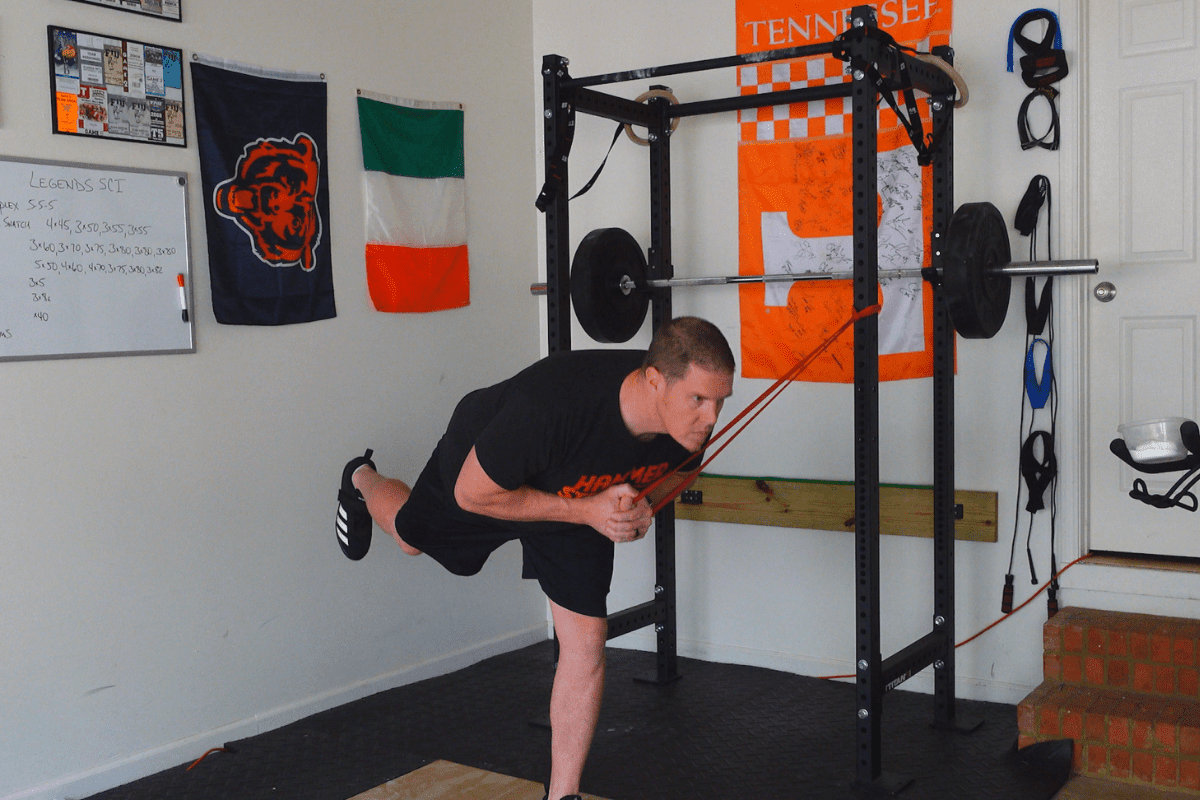Anti-Rotational Single Leg RDL (How To & Alternatives)
Anti-Rotational Single Leg RDL is a simple exercise that has a very long and complicated sounding name.
Anti-Rotational means that we will be holding a band anchored to a rack. The purpose of the band is to create a lateral pull against the body that we will have to stabilize against. In other words, ‘not rotate’.
Not counting the addition of the band, it’s a simple Single Leg RDL where we’ll be standing on one leg and hinging at the hip.
The Anti-Rotational SL RDL is a great warmup exercise that engages both the core and the glute med. Perfect for Olympic lifting and/or squatting workouts. In this guide I’ll show you how to do an Anti-Rotational SL RDL, common mistakes and some alternatives in case you need them.
This article contains affiliate links. If you make a purchase through one I may earn a commission.
How To Do an Anti-Rotational Single Leg RDL
Equipment Needed
- Resistance Band (Preferably a thin one)
- Something to anchor the band. A Squat Rack works great for this.
Instructions
- Start by looping a band around the vertical beam of a squat rack.
- Stand far enough away from the rack to get proper tension on the band. You should feel the band pulling and trying to rotate you, but not so much that you cannot maintain your balance.
- Grab the band with one hand and then place the other hand over top.
- Start with your hands right in front of your sternum.
- Lift the leg furthest away from the rack up off the ground.
- Now, in a controlled manner, hinge at the hip – lowering the chest and raising the leg at the same rate. Continue lowering until a stretch is felt in the hamstring (or until the torso becomes roughly parallel to the ground)
- Re-trace the movement and return to the starting position. Complete the designated number of reps and then switch to the opposite side.
Coaching Points
Don’t rush the movement. Stay under control and focus on staying stable and balanced.
One of the most common mistakes I see on a Single Leg RDL is moving the torso down before lifting the leg up. The torso and leg should move simultaneously, like a teeter-totter, on the way down and on the way up.
If you find yourself really struggling to maintain balance, don’t get frustrated. Remove the band and just work on doing bodyweight Single Leg RDLs. Once you become proficient with those, add the band back in.
Muscles Worked
The Core and Glute Med are both worked during the Single Leg RDL because the band forces those areas to work to stabilize the body and not allow it to rotate. The hamstrings are involved a little here as well, but not much because of the lack of resistance (holding a barbell or dumbbell).
Anti-Rotational Single Leg RDL Alternatives
If you don’t have a band, or you’re really struggling to hold your balance – here are a few alternatives you can try.
Bodyweight Single Leg RDL
Removing the band takes away the anti-rotational element of the exercise, but a Bodyweight Single Leg RDL is still a great warmup exercise. It’s a great range of motion for the glutes and hamstrings and still can help improve balance and proprioception.
If you have access to an Airex Pad, you can stand on it to increase that emphasis on balance and proprioception.
Lateral Bridges
If you’re looking for an alternative movement that will give you similar core and glute activation, try Lateral Bridges.
Lateral Bridges are basically a side plank with some added movement.
Start in that side plank position, one elbow on the floor, the other on the hip. Shoulders (as well as the hips and feet) should be stacked vertically, one directly above the other. Now, lift the hips off the ground to achieve the full side plank position.
From here, drop the hips down and lightly tap the floor and then raise the hips back up to their original position. Continue for the desired number of reps.
More Links and Info
If you’d like to see more warmup and activation drills, head over to the Warmup section of our Exercise Library. There you’ll find dozens of exercises, all with complete detailed instructions.

